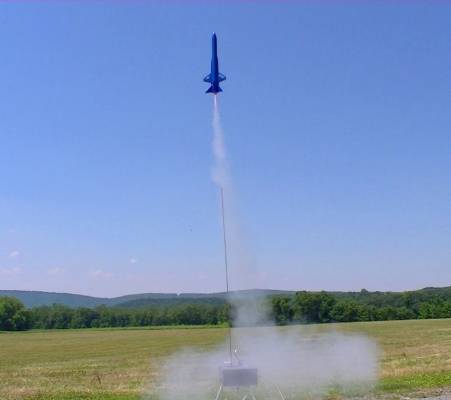The X-15: This is a "Sport-Scale" (not true scale) model of the famous X-15 rocket-powered research plane. This particular kit appears to be newer than other Quest X-15 kits described here: It is a few inches longer, and a recommendation by Quest to only use the A8-3 or A6 motors. (Mine is definitely too heavy to fly on an A8). I chose to paint my particular model gloss blue (not the historically accurate black).
My kit came out pretty heavy as I used a full-sized can of Rustoleum 2X paint trying to get a smooth, glossy finish. Apparently light coats of this paint leave the finish in something like an orange-peel texture, cool but not good for low drag. I discovered heavy, thick coats that would run with normal paints made for a smoother, glossy finish. But by then, there was so much primer and paint on this model that it almost doubled the weight of this kit. In MHO, Rustoleum 2X (from Home Depot) sucks for flying models. I wish I would have used the ridiculously expensive yet lighter Testors stuff at $5 for a tiny 3-oz. can.
The X-15 finally got a payload section addition. This adds another 3 inches to the rockets overall length. This will hold the Altimeter Two, which no longer is at risk of ejection shock damage or loss if the clip fails. The added bulkhead, painted payload tube and padding only adds an additional 13.6 grams of weight to this model.
She flies well and is not affected by the wind much, though I wish I could get her to venture a little closer to the clouds. Actual measurements with an altimeter on board shows this model can go much higher than I estimated, with a C6-3 it reached 437 feet, and traveled at 89 mph. That's enough to have it fly higher than the Great Pyramid of Giza, now that it has eroded about 25 feet.
| Flight Date: | 2012-06-10 |
| Rocket Name: | X-15 |
| Kit Name: | Quest - X-15 {Kit} (2014) |
| Flyer's Name: | Rich DeAngelis |
| Motors: | B6-4 |
| Launch Site: | Halifax, PA |
| Actual Altitude: | 149 Feet |
I needed to test this model with a B6 motor some more. The last B6 flight with a -2 delay was clearly not enough so for this flight the B6-4 was to be tested.
The liftoff was brisk, with accelerations higher than previously recorded for this rocket, peaking at 8.4 Gs and averaging 3.4Gs for the 8/10 second burn. This model then reached a top speed of 56 mph. The actual delay was a full second short and occurred at 127 feet. After 1/10 second it reached an apogee of 149 feet (one foot higher than the previous flight) with the parachute still in the tube. The rocket continued down for a nervously long time with only the nose cone out, appearing to be heading for disaster.
Eventually the ‘chute was pulled out in the turbulence and it opened. The model descended at 12 mph and landed about 50 feet away. Flight time was only 11 seconds. As I expected, flights with this model would be much more impressive with a C6 motor, B6’s are hardly worth the effort.
| Stage | Motor(s) |
|---|---|
| 1 | Estes B6-4 |
 |
 |

